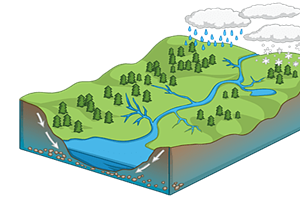Statistical modelling of suspended sediment transport in the Cherf drainage basin, Algeria
Résumé
This work deals with the main topic of the assessment of the Cherf drainage basin sediment yield based on available water discharge and suspended sediment concentration observations, and on the application of general and multivariate models. This study is also part of a broader effort aiming to predict reservoir siltation and future reliability. The 19 years of available sediment concentration data (1975/1976-1993/1994) is used to predict suspended sediment loads. From 1994, this drainage basin has shown a construction of a reservoir at its outlet (Cherf dam) for civil and industrial use. From that date, only monthly water volumes are used to estimate sediment yield in the reservoir. The methodology involved in this study is developed by a conventional sediment rating curve and a multiple regression model. The former method is investigated with the mean discharge classes derived from the recorded suspended sediment concentrations and water discharges for the Cherf drainage basin (1710 km²), prior to the reservoir construction. The later is based on rock type erodibility, mean annual runoff and basin area variables, and which is applied for the ungauged reservoir basin of 1735 km². For the rating curve model, a regression analysis is made between the instantaneous suspended sediment concentration (C) and the instantaneous water discharge (Q) based on all recorded data and seasonal ratings. Optimization of rating curve method is validated by comparing the predicted against observed values on scatter plots.
Téléchargements

Téléchargements
Comment citer
Numéro
Rubrique
Licence

Revue Marocaine des Sciences Agronomiques et Vétérinaires est mis à disposition selon les termes de la licence Creative Commons Attribution - Pas d’Utilisation Commerciale - Partage dans les Mêmes Conditions 4.0 International.
Fondé(e) sur une œuvre à www.agrimaroc.org.
Les autorisations au-delà du champ de cette licence peuvent être obtenues à www.agrimaroc.org.

